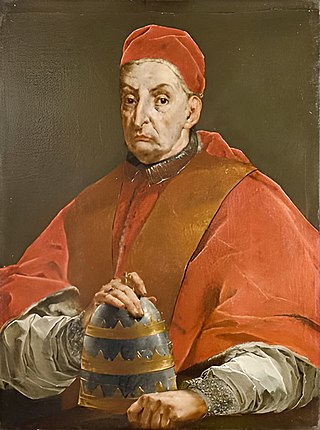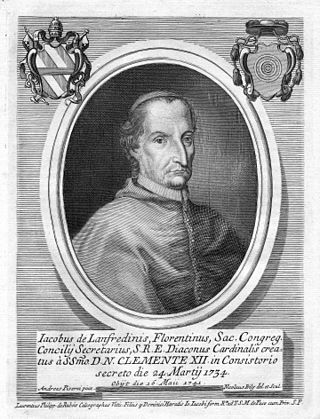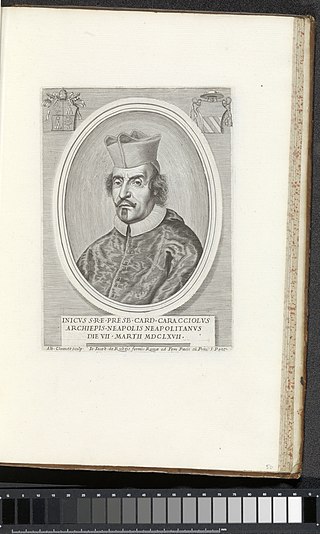This article includes a list of references, related reading, or external links, but its sources remain unclear because it lacks inline citations .(June 2018) |

Antonio Banchieri (19 May 1667 - 16 September 1733) was an Italian cardinal.
This article includes a list of references, related reading, or external links, but its sources remain unclear because it lacks inline citations .(June 2018) |

Antonio Banchieri (19 May 1667 - 16 September 1733) was an Italian cardinal.
Born in Pistoia, he belonged to the Banchieri noble family and was the son of Niccolò, gonfaloniere of Pistoia and knight of Santo Stefano, and his wife lady Caterina Rospigliosi. His uncles were cardinals Giacomo Oddi and Giovanni Francesco Banchieri. On his mother's side he was a great-grandson of pope Clement IX and nephew of cardinals Giacomo Rospigliosi and Felice Rospigliosi. He began his studies at the Collegio Tolomei in Siena in 1679, before moving to the Seminario Romano in Rome, graduating as a doctor utroque iure on 10 July 1692.
During the pontificate of pope Innocent XII he was made participating apostolic protonotary on 27 June 1692 and then referandario to the Apostolic Signatura on 16 July 1692, a role he held until 1725. He also became relatore to the Sacra Congregazione della Sacra Consulta and then consultore to the Sacred Congregation of Rites. He became ruling secretary to the Sacra Congregazione della Propaganda Fide in the absence of secretary Agostino Fabroni in July 1702 and consistorial advocate and vice-legate to Avignon from 23 December 1702 to 8 August 1706. In 1706 the pope intended to make him apostolic nuncio to France, but Banchieri declined the role since it would require him to be ordained a priest. He was made secretary to the Sacra Congregazione della Propaganda Fide in May 1706 and then assessor of the Suprema Sacra congregazione della Romana and the Universal Inquisition in August 1707. He was secretary to the Sacra consulta from 3 October 1712 to 1724, then a member of the Special Congregation which discussed the "Riflessioni morali sul Nuovo Testamento" (Moral Reflections on the New Testament) by the Jansenist Pasquier Quesnel.. He also served as governor of Rome and vice-camerlengo from 30 September 1724 to 30 April 1728.
He was made a cardinal in pectore in the consistory of 9 December 1726 - his appointment was made public in the consistory of 30 April 1728 and he received his cardinal's biretta and the titulus of San Nicola in Carcere on 10 May that year. He took part in the 1730 conclave which elected pope Clement XII, who made Banchieri Secretary of State and prefect of the Sacra Consulta on 15 July 1730, roles he held until his death. In 1730 he became a member of the "De nonnullis" Congregation, in which he clashed with cardinal Niccolò Coscia. He was also later made prefect of the Holy House of Loreto, of the city of Fermo and of the Comtat Venaissin. He had an apoplexic fit in July 1733 and was critically ill for a time, before recovering. This did force him to retire to his home in Pistoia on 29 August that year, where he died only a fortnight later. His body lay in state for public veneration before being buried in Santissimo Nome di Gesù church in Pistoia.

Pope Benedict XIII, born Pietro Francesco Orsini and later called Vincenzo Maria Orsini, was head of the Catholic Church and ruler of the Papal States from 29 May 1724 to his death in February 1730.

Pope Clement IX, born Giulio Rospigliosi, was head of the Catholic Church and ruler of the Papal States from 20 June 1667 to his death in December 1669.

Pope Clement XII, born Lorenzo Corsini, was head of the Catholic Church and ruler of the Papal States from 12 July 1730 to his death in February 1740.

The Congregation for the Evangelization of Peoples was a congregation of the Roman Curia of the Catholic Church in Rome, responsible for missionary work and related activities. It is also known by its former title, the Sacred Congregation for the Propagation of the Faith, or simply the Propaganda Fide. On 5 June 2022, it was merged with the Pontifical Council for Promoting the New Evangelization into the Dicastery for Evangelization.

The Secretary of State of His Holiness, known as the Cardinal Secretary of State, presides over the Holy See's Secretariat of State, which is the oldest and most important dicastery of the Roman Curia. The Secretariat of State performs all the political and diplomatic functions of the Holy See and the Vatican City State. The secretary of state is sometimes described as the prime minister of the Holy See, even though the nominal head of government of Vatican City is the President of the Pontifical Commission for Vatican City State.

The diocese of Montefiascone was a Catholic ecclesiastical territory in Italy. It was created from the diocese of Bagnorea in 1369. In 1986 was united into the diocese of Viterbo, Acquapendente, Bagnoregio, Montefiascone, Tuscania e San Martino al Monte Cimino. The diocese was immediately subject to the Holy See (Papacy).

Benedetto Pamphili was an Italian cardinal, patron of the arts and librettist for many composers.

Bandino Panciatici was a Roman Catholic cardinal from 1690 to 1718.

Pope Benedict XIII created 29 new cardinals in 12 consistories:
Niccolò Pandolfini (1440–1518) was an Italian Roman Catholic bishop and cardinal.

Marcello Semeraro is an Italian prelate of the Catholic Church who has been the Prefect of the Congregation for the Causes of Saints since October 2020. He was previously Bishop of Albano and secretary to the group of cardinals named by Pope Francis to advise him.

The House of Rospigliosi is an ancient noble Italian family from Pistoia. Attested since the Middle Ages, it became wealthy through agriculture, trade and industry, reaching the apogee of its power and the high nobility status in Rome thanks to Giulio Rospigliosi, elected pope in 1667 with the name of Clement IX.

Pietro Marcellino Corradini was an Italian Roman Catholic cardinal. Corradini served in various departments of the Roman Curia under several popes and founded the Collegine Sisters of the Holy Family as a response to the demand for religious instruction for girls.

Giacomo or Jacopo Rospigliosi was an Italian Roman Catholic cardinal.

Felice Rospigliosi was an Italian cardinal.
The Sacred Congregation of the Consulta or Sacra Consulta was a dicastery of the Roman Curia. It was set up as a 'special commission' by pope Paul IV in 1559 and officialised on 22 January 1588 by Pope Sixtus V in the papal bull Immensa Aeterni Dei. Sixtus named it the 'Congregation over the consultations of the ecclesiastical state' and established its composition of four cardinals, the Secretary of State as prefect and a suitable number of prelates, one of whom would act as secretary.

Giacomo Lanfredini was a Roman Catholic cardinal who served as Cardinal-Deacon of Santa Maria in Portico (1734–1741) and Bishop of Osimo e Cingoli (1734–1740).

Innico Caracciolo the Elder was a Roman Catholic priest, cardinal and archbishop.
Francesco Ravizza was an Italian archbishop and diplomat, Apostolic Nuncio to Portugal from 1670 to 1673.

Santo Spirito, once called the church of Sant'Ignazio, is a Roman Catholic church in Pistoia, region of Tuscany, Italy.